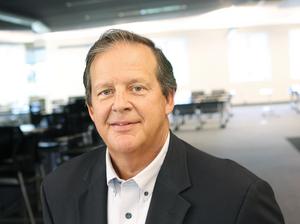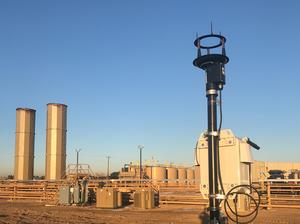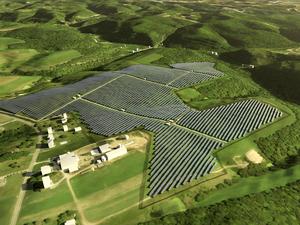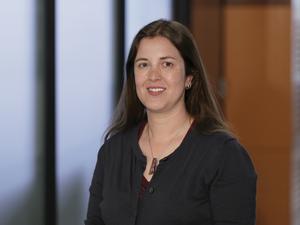Approach the WindStax turbines, just to the right of the Pitt Ohio Transportation Group terminal off Route 28, and you'll be forgiven for taking a second glance at the gray and red structures that rise only slightly above the building on a bluff overlooking Harmar Township.
These are not your parents' wind turbines.
A traditional turbine, apparent to anyone who has ever driven on the Pennsylvania Turnpike, looms large on the landscape, rising into the air with three long blades that slice through the sky. But WindStax Energy, the Pittsburgh-based company that designs and builds turbines for their custom-designed microgrids, takes a slightly different approach.
Its products are vertical, rising just under 40 feet into the air, with four sections that catch the wind and generate electricity. WindStax's generator and machinery are, unlike the horizontal turbines, on the ground below.
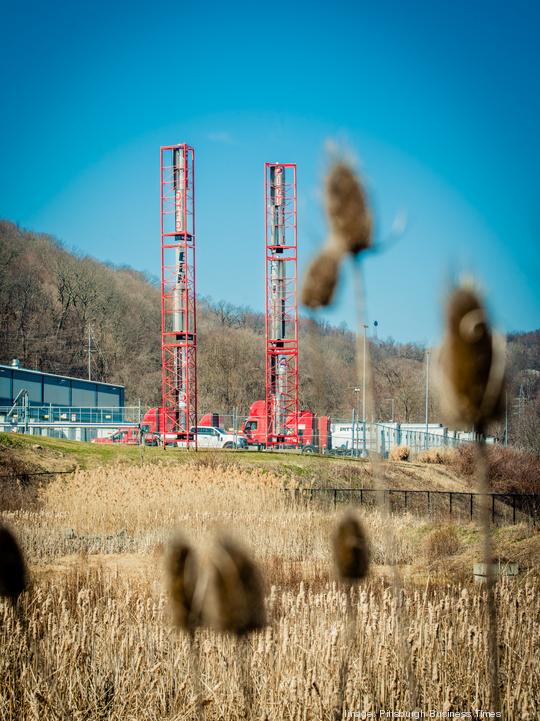
It’s here in Harmar, along with another terminal in Ohio, where WindStax and Pitt Ohio are writing a new chapter in renewable, sustainable energy. The terminals in both places include an office building, a warehouse and loading facility, and places where trucks and loading equipment are parked before they are sent on their way. But what’s unique is the microgrids that have been built at each site. Each microgrid uses a combination of wind and solar energy to generate most of the facility’s power on a 24/7 basis, taking electricity from PJM Interconnection’s grid sparingly.
To Jim Fields, COO of Pitt Ohio, WindStax and its founder/CEO Ron Gdovic aren't just contractors building the microgrid and then leaving. Rather, Pitt Ohio and WindStax are models for how companies can partner for sustainability and use renewable energy profitably.
"I would call Ron and WindStax strategic partners because there's so much more that they're doing than just providing us with wind turbines for sustainable power," Fields said.
Building a microgrid
Pitt Ohio, which has terminals in the Midwest and Northeast and is headquartered in the Strip District, first saw an opportunity to use renewables with the construction of a LEED-certified trucking terminal in East Windsor, New Jersey.
That first project wasn't built with renewables in mind. But there were a few spare acres where Pitt Ohio decided to place solar panels, which power 100% of the terminal. That led the company to ponder whether the Harmer facility could also be powered by renewable sources.
It began working with the University of Pittsburgh to see if its experts could design a solar-powered system that would power much of the terminal. Then Pitt Ohio began to think about whether wind energy could also play a role. That was around the time of a serendipitous encounter in 2011 that changed the course of both Pitt Ohio and WindStax.
Fields and some of his team had gone out for lunch at the Smallman Street Deli, near their Strip District headquarters, when they noticed a sign for WindStax. Gdovic came out and introduced himself. They got to talking, and more than lunch was on the menu.
Gdovic, an entrepreneur and longtime green energy enthusiast, founded WindStax in 2011 on $250,000 and soon after set up shop in the Strip District, where he and his employees designed and built the vertical-axis turbines that produced electricity and included battery storage for the times when the wind isn’t blowing.
The company initially focused on installations at residential and small commercial and government projects, places that could run off the grid. While it saw some success building these systems, WindStax found it difficult to compete on a per-watt basis. That led Gdovic and WindStax to pivot toward microgrids, which are self-sustaining power systems that use one or two energy sources — in this case, wind and solar. Microgrids have become more popular in recent years, with high-profile power failures at busy airports, wildfires in California in 2020 and the ice storms that caused widespread outages in Texas.
“Many people are really thinking not only about sustainability, but also about resilience,” Gdovic said. “That’s where a microgrid comes in.”
Microgrids have been employed by forward-thinking companies and organizations who wanted to have more control over their energy future. They qualify for federal tax credits, the Investment Tax Credit (ITC) of between 12% and 30% depending on the project costs and, when up and running, a tax credit of under 2 cents an hour for the first 10 years of utility-scale power generation from wind. That can be an especially powerful incentive for a company to spend the money to install a microgrid like WindStax’s, as well as the chance to lower costs even further by selling back power to the larger grid.
Fields credits Gdovic and Gregory Reed, an electrical and computer engineering professor at Pitt, for helping guide the company to the system that it has now at Harmar, which began operating in 2014. It takes the best of both renewable worlds, solar arrays on the left side of the building that soak in during the daylight, and the wind generation that usually kicks in at night in Harmar. The microgrid uses the renewable energy first, a battery backup second and then the utility last.
“You couldn’t go out and buy a system like this,” Fields recalled. “It didn’t exist, where you have wind and solar generated power being fed into storage batteries and utilized as needed.”
WindStax takes a data-driven approach to placing turbines. The Pittsburgh region isn’t known for the kind of sustained wind speeds that wind turbines prefer. To counter that and to find the best location, the company spends a year or two collecting data with monitors that check wind speed and direction. Gdovic said it used the information gleaned from there to determine the best location for the turbines at the Harmar facility.
Unlike many wind turbines, WindStax’s are built top to bottom in its Plum Borough facility from 100% American-made components. The company, which employs six and declined to disclose revenue figures, uses 100% recycled steel, down to the foundations. It uses small American manufacturers to build the gears and generators. Some of the circuitry, such as conduits and switches, are now made by WindStax at its Plum Borough plant.
Being American-made is a big selling point, and it’s important to Gdovic. It also squashes complaints by some that wind energy is anything but American-made.
Adding the batteries to the equation was also a particular requirement on Pitt Ohio’s list: Its power usage is up and down over a 24-hour period, making it critical for battery usage to avoid drawing from the outside electrical grid.
The installed battery system is from Aquion Energy, although Gdovic and WindStax are in the midst of upgrading the battery to a system that takes advantage of the better storage and technology leaps that have occurred since Aquion filed for bankruptcy. Aquion’s was a salt-water battery. The new battery, Gdovic said, is lithium-ion.
The battery upgrade will also come with a benefit for Pitt Ohio: It will be able to add about 200 kilowatts of solar to the site, which will mark a milestone. The previous battery system, installed in 2014, wasn’t designed to power the entire building. It does about 85% now, according to Fields. That will change with the new battery and additional solar.
“They will not have to rely on the grid anymore,” Gdovic said.
‘We’ve had people come from all over the world to see it’
Last year, Pitt Ohio received a patent for the process it and WindStax employed in Harmar to create the solar/wind and battery system. And, between the Harmar system’s deployment and the patent, Pitt Ohio and WindStax outfitted Pitt Ohio’s terminal in Parma, Ohio, near Cleveland, with a $2 million renewable energy microgrid.
This project is at a much larger scale than the one in Harmar: Eight WindStax turbines that are six stories high that generate 32 kilowatts of wind power alongside 495 kilowatts of solar panels and a 1-megawatt battery storage system. While the project is significantly larger, Fields said feedback from the Harmar project informed the design and operation of Pitt Ohio’s Parma terminal. It uses the improved technology that has become available since the Harmar microgrid was built, as well as the multitude of data that WindStax provides on a moment-by-moment basis to Pitt Ohio on its microgrid and energy production.
“We took significant advantage of what we learned from the metrics we got from Harmar and designed it into Parma,” Fields said. About 90% of the terminal’s energy needs come from the renewable sources.
The Harmar terminal has become a case study of sorts, a model of what wind energy can be for companies and governments that might have shunned it in the past. That has been good news for both WindStax and Pitt Ohio.
“We’ve had people come from all over the world to see it,” Fields said. One team, from a European company in charge of their sustainability process, traveled to see both Harmar and Parma.
“They said they haven’t found anything that is like it,” Fields said.
While nothing has been announced, Pitt Ohio is far from done when it comes to sustainability and energy resilience. The two companies are looking at ways to bring resilience and renewable energy to other Pitt Ohio facilities, and Pitt Ohio believes the systems will come in handy with the eventual transition to electric vehicles.
Fields said there are a lot of benefits to the company’s renewable energy and sustainability initiatives, starting with a lower carbon footprint and even including talent attraction and retention.
“It doesn’t make us beholden to the grid as much, when we can generate power at our facility,” he said. “And remember, there are a lot of customers who want to align themselves with like-minded suppliers like us who are focused on reducing the carbon footprint. And there are a lot of young people who select where they want to work by how much you align with their life philosophy.”
Gdovic said businesses in Pennsylvania and Ohio that make a big investment into renewables, taking into account the federal investment tax credit, can see a return on investment in between five to seven years. It can be shorter if businesses take advantage of the depreciation acceleration programs.
But that only gets into a fraction of the cost analysis, Gdovic said.
“As important or more important is the issue of resilience,” he said. “The cost of being unable to operate in a utility outage could be in the six-figures per hour. The benefit of a microgrid system being able to island, as we call it, is they can operate independent of the (PJM) grid. It’s a significant risk mitigation factor that should be and normally is taken into account.”
Not all of WindStax’s microgrid projects are as big as the Pitt Ohio microgrids. WindStax is installing a microgrid at Legrand’s Canonsburg manufacturing plant whose requirements are for the battery backup to work for four hours before shutting off, allowing them to power down the facility for an extended outage. It has about 50 kilowatts of solar and 100 kilowatt-hours in battery storage. Another WindStax project, Epic Metals in Braddock, has a microgrid whose battery backup powers everything for an hour.
WindStax also has built a 20-foot vertical turbine, solar panels and battery microgrid system on the Eden Hall Campus of Chatham University. And in November, it held a ribbon-cutting of a 40-foot turbine at the Rivers of Steel Pump House, alongside the remnants of the steel industry in Munhall.
The company, which is privately held, came off record years in 2018 and 2019 only to hit a pandemic-related wall in 2020 like so many other businesses. The uncertainty led to several projects being canceled or postponed. A $36,000 Paycheck Protection Program loan helped, mostly payroll and a bit for rent and utilities. So did WindStax’s designation as an essential business. Still, the company did mostly service work and upgrades in 2020.
Gdovic sees WindStax expanding in 2021 and beyond. It’s hiring an electrical engineer to work with design and installations, and it’s expanding its installation crew later this spring.
“We’ve seen a surge in microgrid demands based on risk mitigation alone” after the Texas power outages of the past winter, Gdovic said. “I believe the more progressive companies are recognizing that they are something that can manage to make sure that their operations are not beholden to a utility company or the weather, that they can see some proactive role. We’re certainly seeing an uptick in demand.”
One of the big growth areas is the microgrid for cellphone towers, an area that Gdovic said hasn’t been seen in the United States and could be a big opportunity that’s right for WindStax.
“We would like to expand, primarily in SolarStax, with the telecommunications industry,” Gdovic said. “That would be national and international.”

